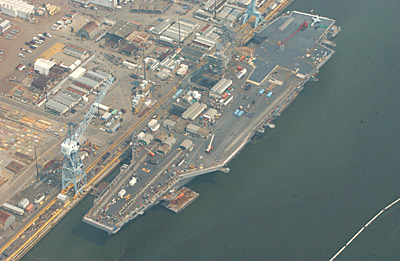Post by Keith Heitmann on Jul 25, 2004 1:11:53 GMT -5

The Eisenhower will be moved to a new pier at Northrop Grumman Newport News on Saturday to test and certify some of its overhauled systems. PHOTOS BY ARIANA LINDQUIST/THE VIRGINIAN-PILOT
By MATTHEW DOLAN, The Virginian-Pilot
© July 22, 2004
NEWPORT NEWS — It’s the Navy’s version of “Extreme Makeover.”
First, you find an aging aircraft carrier in need of a face lift. Then you rip open its heart to juice up its power source. You tear out, repair or replace almost everything from berthings to bulkheads, seal up the decks and finally, call it a day.
Or, in the case of the Dwight D. Eisenhower, call it three years.
“Being at sea is fun,” Capt. Charles E. Smith, the carrier’s commanding officer, joked while barreling down an unfinished passageway deep inside the ship. “Being here is hard work.”
On Saturday, the nation’s second Nimitz-class carrier will move from its temporary pierside home at Northrop Grumman Newport News to another pier at the shipyard to test its propulsion systems and certify its radar capabilities.
It’s the latest milestone in the carrier’s once-in-a-lifetime nuclear refueling and overhaul, bringing the flattop one step closer to a return to sea by November.
The carrier, commissioned in 1977, arrived at the shipyard in May 2001. Much of the heavy work for the $1.5 billion project, including the refueling of the two nuclear reactors, is now complete.
But while on time under a new construction schedule, challenges remain.
During the first visit by a reporter to the carrier in three years, miles of exposed cable and duct work could still be seen this week clogging passageways throughout the ship.
When the carrier moves on Saturday , it won’t be able to steam under its own power. There are no pilots on board. That’s a good thing because their ready rooms aren’t ready.
Only two of the carrier’s four catapults used to launch aircraft have been completely rebuilt. And the pebbly, non skid surface on the flight deck is only one-quarter complete.
“Non skid is a unique animal,” said Robert L. Gunter Jr., senior vice president for the aircraft carrier program for Northrop Grumman Newport News. “You can’t put it on in less than 40 degrees or when it gets greater than 100. And you can’t put it on if it’s going to rain in the next 24 hours.
“That middle section there,” he said, pointing to a grainy tar patch in the rear half of the flight deck, “it had to be taken up four times.”
Safety on the carrier, already one of the world’s most dangerous environments, carries special weight in the yards.
On the Ike, cutting metal, sanding surfaces and laying new floors are a daily event. Sailors in uniforms and shipyard workers in T-shirts are all required to wear hard hats and safety glasses.
“We’ve had a lot of bumps, bruises and cuts,” said the Ike’s senior medical officer, Lt. Cmdr. Walter Dalitsch III . “But so far, no serious accidents.” The crew has hauled its gear back onto the Ike slowly.
About 700 have moved aboard so far, with hundreds more expected to arrive in the next two weeks. Ike executive officer Capt. John D. Alexander said 186 arrived this week alone.
It has created a surreal environment for sailors living, eating and sleeping in the midst of a busy construction zone. Many services are displaced. Some of the soda machines and cafeteria-style tables, normally in the ship’s mess decks, take up space in the hangar bay where aircraft once stood.
“Eighty or 90 percent of them have never been to sea or even lived on a ship,” Master Chief Petty Officer Rodney Malbon , a 17-year Navy veteran who works in the Ike’s reactor department, said of his junior sailors. “It’s been a real adjustment for them, especially dealing with the lack of space.”
Petty Officer 2nd Class Tracy Dalton said the sailors have pride of ownership when they assembled their furniture in their own berthings.
Her space is now air-conditioned, and after 11 every night the shipyard has orders to scale back the most noisy work it does so she and others can grab some shut-eye.
Despite the challenges of serving on a ship that has not deployed in years, Smith said the Ike’s statistics for advancement, retention and discipline remain among the top three for carriers in the Navy.
The overhaul centers primarily on replacing two decks off the ship’s island house, modernizing its combat and communications systems, replenishing its two reactors and replacing about 6,000 valves.
There are smaller, quality-of-life changes, too.
The beds, a.k.a. “racks,” are longer to accommodate taller sailors. The bathrooms, or “heads,” have been retiled. And they’re building a second gym off the hangar bay.

The three-year overhaul centers on replacing two decks off the ship’s island house, modernizing its combat and communications systems, replenishing its two reactors and replacing about 6,000 valves.
But much of the niceties are still on the way. The officers’ wardroom lounge has new furniture but an empty space where a television should sit.
“When we’re at sea,” Smith said, grinning , “then they can watch TV.”
All Nimitz-class aircraft carriers are scheduled to undergo reactor regeneration and overhauls after about 25 years of service. The carrier Nimitz, the first ship of its class, went through its overhaul between 1998 and 2001 at Newport News.
Last year, the Navy and Northrop Grumman agreed to restructure their contract for overhauling the carrier by extending the work 11 weeks and reducing the minimum profit the shipyard will realize if work is completed late or is more than 5 percent over budget.
“Nothing happens without both of us working together,” Smith said.

